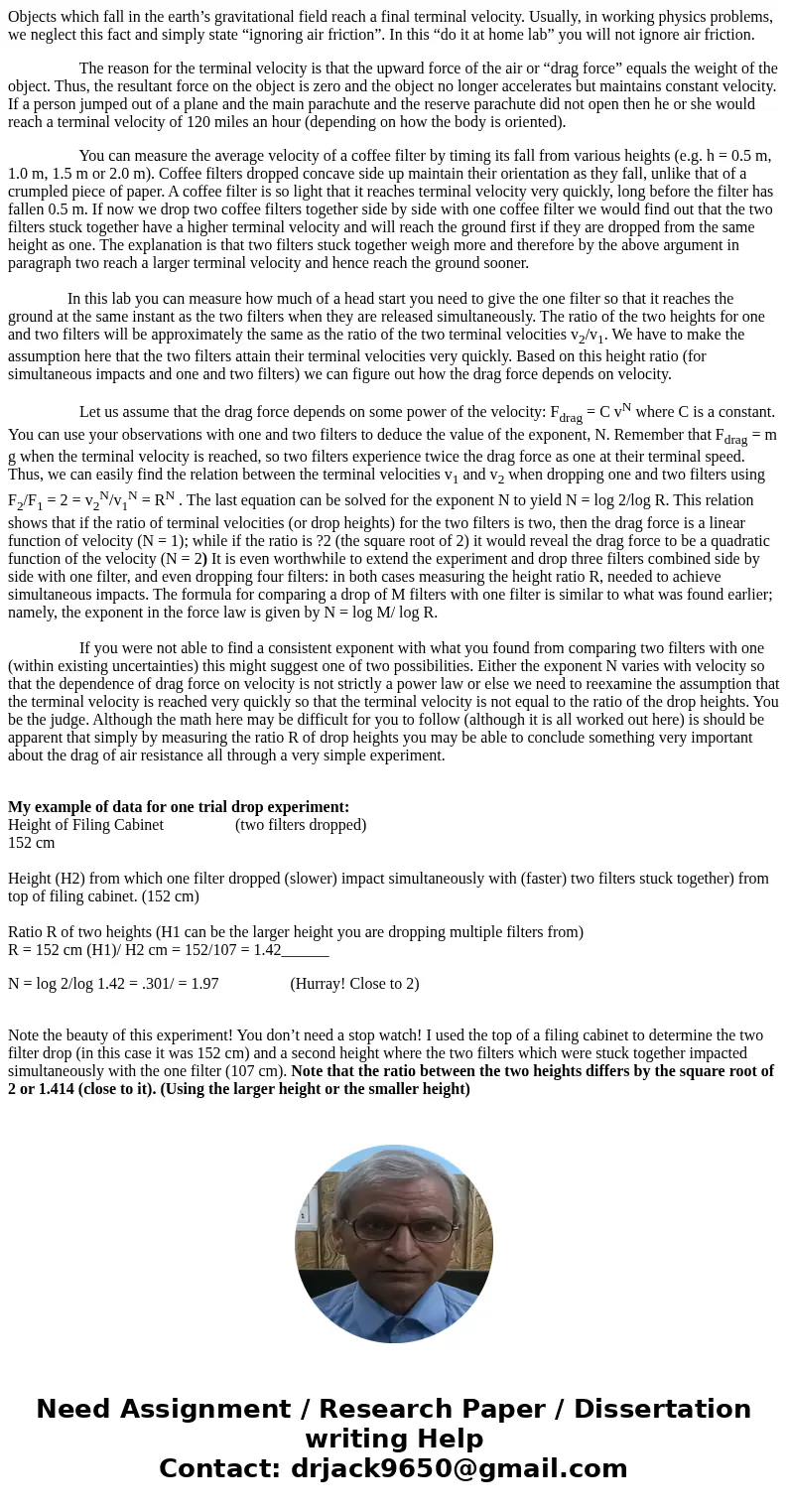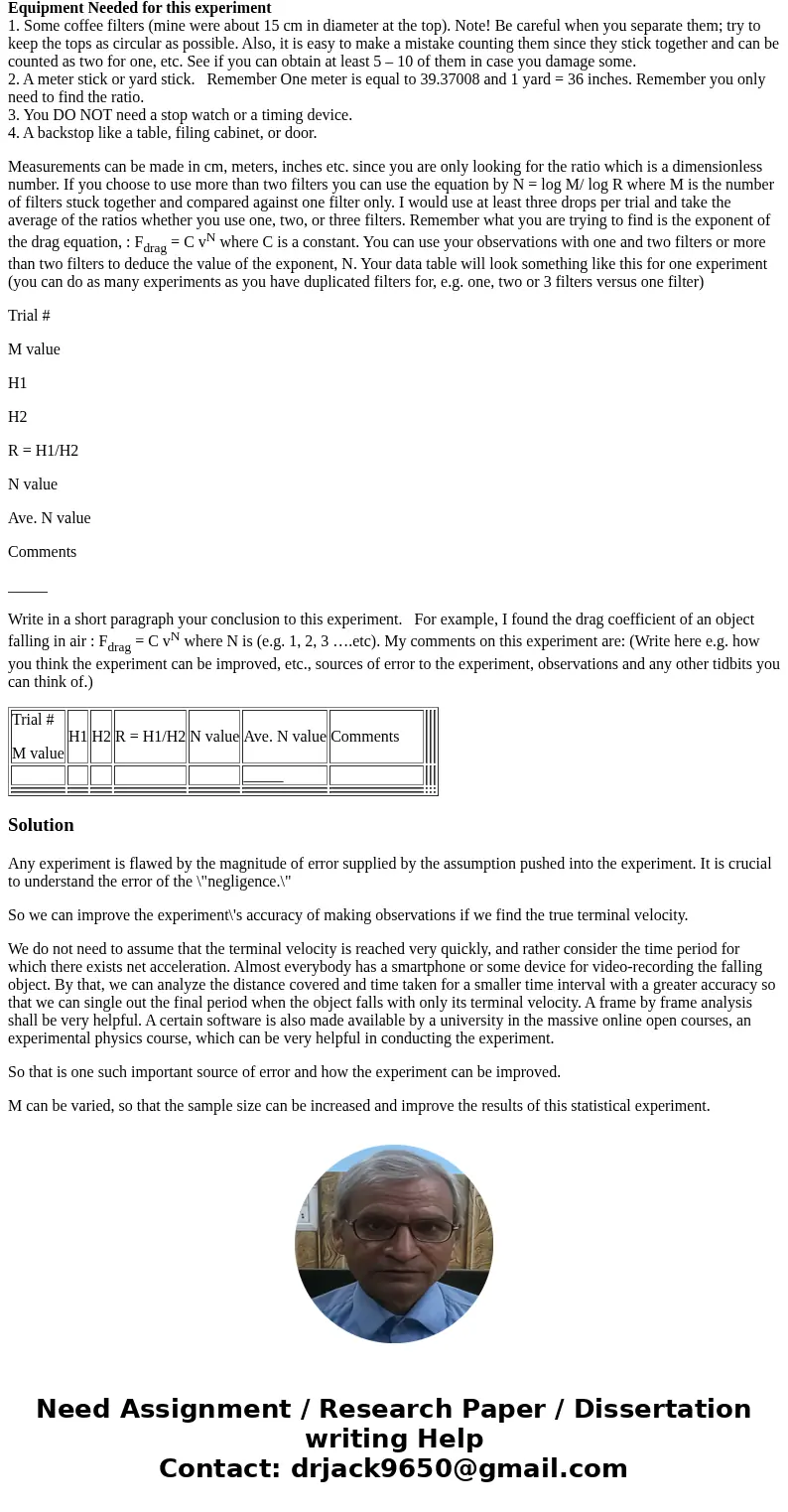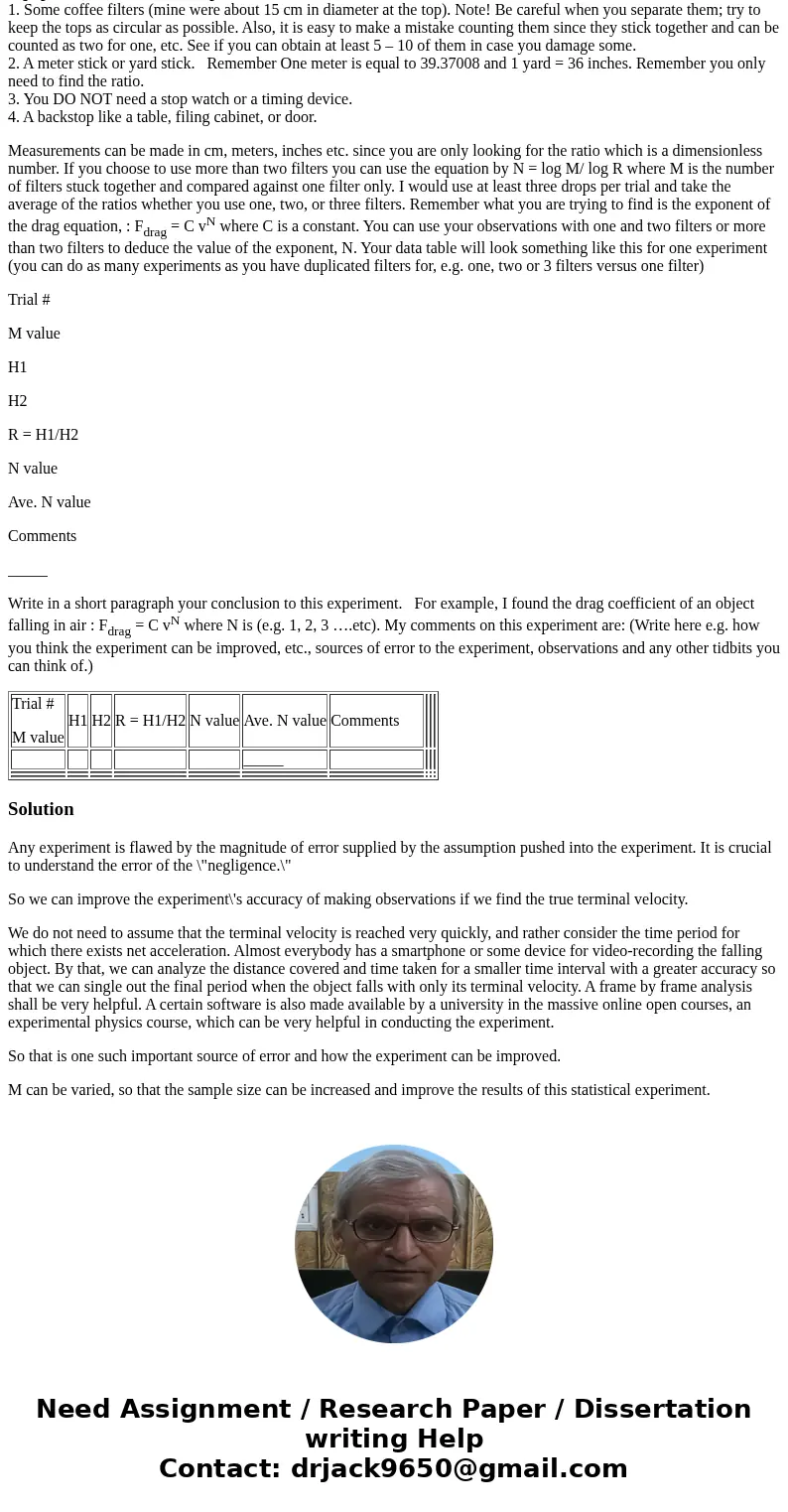Objects which fall in the earths gravitational field reach a
Objects which fall in the earth’s gravitational field reach a final terminal velocity. Usually, in working physics problems, we neglect this fact and simply state “ignoring air friction”. In this “do it at home lab” you will not ignore air friction.
The reason for the terminal velocity is that the upward force of the air or “drag force” equals the weight of the object. Thus, the resultant force on the object is zero and the object no longer accelerates but maintains constant velocity. If a person jumped out of a plane and the main parachute and the reserve parachute did not open then he or she would reach a terminal velocity of 120 miles an hour (depending on how the body is oriented).
You can measure the average velocity of a coffee filter by timing its fall from various heights (e.g. h = 0.5 m, 1.0 m, 1.5 m or 2.0 m). Coffee filters dropped concave side up maintain their orientation as they fall, unlike that of a crumpled piece of paper. A coffee filter is so light that it reaches terminal velocity very quickly, long before the filter has fallen 0.5 m. If now we drop two coffee filters together side by side with one coffee filter we would find out that the two filters stuck together have a higher terminal velocity and will reach the ground first if they are dropped from the same height as one. The explanation is that two filters stuck together weigh more and therefore by the above argument in paragraph two reach a larger terminal velocity and hence reach the ground sooner.
In this lab you can measure how much of a head start you need to give the one filter so that it reaches the ground at the same instant as the two filters when they are released simultaneously. The ratio of the two heights for one and two filters will be approximately the same as the ratio of the two terminal velocities v2/v1. We have to make the assumption here that the two filters attain their terminal velocities very quickly. Based on this height ratio (for simultaneous impacts and one and two filters) we can figure out how the drag force depends on velocity.
Let us assume that the drag force depends on some power of the velocity: Fdrag = C vN where C is a constant. You can use your observations with one and two filters to deduce the value of the exponent, N. Remember that Fdrag = m g when the terminal velocity is reached, so two filters experience twice the drag force as one at their terminal speed. Thus, we can easily find the relation between the terminal velocities v1 and v2 when dropping one and two filters using F2/F1 = 2 = v2N/v1N = RN . The last equation can be solved for the exponent N to yield N = log 2/log R. This relation shows that if the ratio of terminal velocities (or drop heights) for the two filters is two, then the drag force is a linear function of velocity (N = 1); while if the ratio is ?2 (the square root of 2) it would reveal the drag force to be a quadratic function of the velocity (N = 2) It is even worthwhile to extend the experiment and drop three filters combined side by side with one filter, and even dropping four filters: in both cases measuring the height ratio R, needed to achieve simultaneous impacts. The formula for comparing a drop of M filters with one filter is similar to what was found earlier; namely, the exponent in the force law is given by N = log M/ log R.
If you were not able to find a consistent exponent with what you found from comparing two filters with one (within existing uncertainties) this might suggest one of two possibilities. Either the exponent N varies with velocity so that the dependence of drag force on velocity is not strictly a power law or else we need to reexamine the assumption that the terminal velocity is reached very quickly so that the terminal velocity is not equal to the ratio of the drop heights. You be the judge. Although the math here may be difficult for you to follow (although it is all worked out here) is should be apparent that simply by measuring the ratio R of drop heights you may be able to conclude something very important about the drag of air resistance all through a very simple experiment.
My example of data for one trial drop experiment:
Height of Filing Cabinet (two filters dropped)
152 cm
Height (H2) from which one filter dropped (slower) impact simultaneously with (faster) two filters stuck together) from top of filing cabinet. (152 cm)
Ratio R of two heights (H1 can be the larger height you are dropping multiple filters from)
R = 152 cm (H1)/ H2 cm = 152/107 = 1.42______
N = log 2/log 1.42 = .301/ = 1.97 (Hurray! Close to 2)
Note the beauty of this experiment! You don’t need a stop watch! I used the top of a filing cabinet to determine the two filter drop (in this case it was 152 cm) and a second height where the two filters which were stuck together impacted simultaneously with the one filter (107 cm). Note that the ratio between the two heights differs by the square root of 2 or 1.414 (close to it). (Using the larger height or the smaller height)
Equipment Needed for this experiment
1. Some coffee filters (mine were about 15 cm in diameter at the top). Note! Be careful when you separate them; try to keep the tops as circular as possible. Also, it is easy to make a mistake counting them since they stick together and can be counted as two for one, etc. See if you can obtain at least 5 – 10 of them in case you damage some.
2. A meter stick or yard stick. Remember One meter is equal to 39.37008 and 1 yard = 36 inches. Remember you only need to find the ratio.
3. You DO NOT need a stop watch or a timing device.
4. A backstop like a table, filing cabinet, or door.
Measurements can be made in cm, meters, inches etc. since you are only looking for the ratio which is a dimensionless number. If you choose to use more than two filters you can use the equation by N = log M/ log R where M is the number of filters stuck together and compared against one filter only. I would use at least three drops per trial and take the average of the ratios whether you use one, two, or three filters. Remember what you are trying to find is the exponent of the drag equation, : Fdrag = C vN where C is a constant. You can use your observations with one and two filters or more than two filters to deduce the value of the exponent, N. Your data table will look something like this for one experiment (you can do as many experiments as you have duplicated filters for, e.g. one, two or 3 filters versus one filter)
Trial #
M value
H1
H2
R = H1/H2
N value
Ave. N value
Comments
_____
Write in a short paragraph your conclusion to this experiment. For example, I found the drag coefficient of an object falling in air : Fdrag = C vN where N is (e.g. 1, 2, 3 ….etc). My comments on this experiment are: (Write here e.g. how you think the experiment can be improved, etc., sources of error to the experiment, observations and any other tidbits you can think of.)
| Trial # M value | H1 | H2 | R = H1/H2 | N value | Ave. N value | Comments | |||
| _____ | |||||||||
Solution
Any experiment is flawed by the magnitude of error supplied by the assumption pushed into the experiment. It is crucial to understand the error of the \"negligence.\"
So we can improve the experiment\'s accuracy of making observations if we find the true terminal velocity.
We do not need to assume that the terminal velocity is reached very quickly, and rather consider the time period for which there exists net acceleration. Almost everybody has a smartphone or some device for video-recording the falling object. By that, we can analyze the distance covered and time taken for a smaller time interval with a greater accuracy so that we can single out the final period when the object falls with only its terminal velocity. A frame by frame analysis shall be very helpful. A certain software is also made available by a university in the massive online open courses, an experimental physics course, which can be very helpful in conducting the experiment.
So that is one such important source of error and how the experiment can be improved.
M can be varied, so that the sample size can be increased and improve the results of this statistical experiment.



 Homework Sourse
Homework Sourse